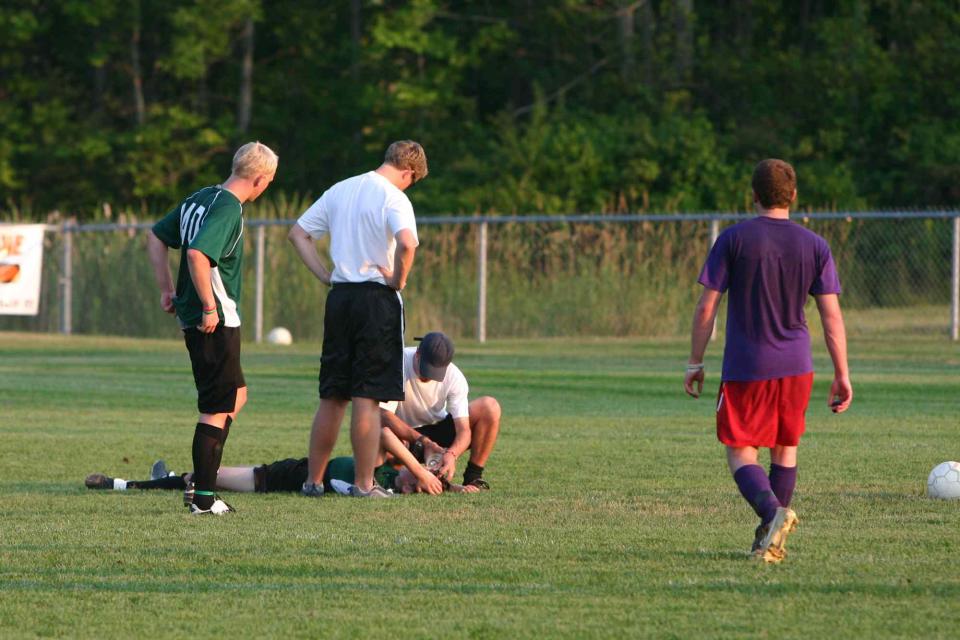Study Shows the Long-Term Impact of Head Injuries in Young Athletes
With the intensity of youth sports on a whole new level these days, the study's findings include critical takeaways for parents.

jpbcpa / Getty Images
Fact checked by Sarah Scott
The brain condition, chronic traumatic encephalopathy (CTE), is typically associated with former professional athletes. Think former NFL players, the late Aaron Hernandez and the late Frank Gifford. But a new study of CTE, which can only be diagnosed after death, has found a link between the degenerative illness, caused by repetitive head impacts (RHI), and young athletes who tragically passed away before the age of 30.
This news comes just as the fall sports season is beginning for young athletes across the country. Youth sports have also only grown more intense in the level of competition and year-round calendar. The lessons learned from the study are critical for parents and their children in contact sports, especially if they've had a concussion or head injury.
Study on CTE in Young Athletes
The study, which was published in JAMA Neurology, looked at 152 deceased young people, 71% of whom participated in sports such as football, ice hockey, soccer, rugby, and wrestling. While most of the athletes were men, this study included the first American woman athlete diagnosed with CTE, who according to a press release, was an unnamed 28-year-old collegiate soccer player.
Among the former amateur athletes the study authors looked at, 41.4% exhibited neuropathological evidence of CTE. It’s notable that whether the athletes had CTE or not, a significant number showed clinical symptoms of the illness, such as depression (70.0%), apathy (71.3%), difficulty controlling behaviors (56.8%), problems making decisions, (54.5%), and substance abuse issues, such as alcohol abuse (42.9%), and drug abuse (38.3%). Suicide and unintentional overdose were the most common causes of death, per the National Institutes of Health.
“This study clearly shows that the pathology of CTE starts early," says corresponding study author Ann McKee, MD, the chief of neuropathology at VA Boston Healthcare System and director of the Boston University CTE Center. "It is imperative that young athletes who are experiencing neuropsychiatric symptoms seek out care, as it is likely that the symptoms can be reduced with effective management and follow-up.”
There is no cure for CTE, but the study found that older athletes (average age at death 25.3 years versus 21.4) who had significantly more years of exposure to contact sports (11.6 versus 8.8 years) were more likely to be diagnosed with the condition.
“This study highlights the importance of assessing the symptoms and clinical presentation of CTE in living athletes who have sustained repetitive head injuries,” notes Nsini Umoh, PhD, the program director for traumatic brain injury (TBI) research at the National Institute of Neurological Disorders and Stroke (NINDS), a funding contributor to this study.
Dr. Umoh also told Parents any activity that exposes children to repetitive brain injuries is inherently risky. “It is important for athletes and their parents to make informed decisions about whether to participate in contact sports, based on the research-to-date,” she explains.
How to Prevent Head Injuries in Young Athletes
If you do allow your child to participate in sports, according to the Centers for Disease Control (CDC), the best way to protect against head injury is for coaches and parents to encourage good sportsmanship and report any head impacts as soon as possible.
Dr. Umoh says having a concussion action plan in place is also key, which would include immediate removal of the athlete from the game or practice, seeking medical care right away, and recording and reporting all symptoms. You also want to ensure your athlete has medical clearance before returning to school and sports.
“Overall, the positives of participating in youth sports outweigh the negatives,” says Daniel Gustkey, DO a pediatric neurologist at Pediatrix Specialty Care of Austin. “Certain sports and activities have a higher incidence of concussions than others, so it is especially important to closely monitor these athletes for any signs and symptoms of brain injuries. The most important aspect of head injuries is complete recovery before returning to athletics to reduce the likely hit of a second hit which prolongs recovery.”
Be sure to look for the following signs and symptoms of a concussion or head injury in your child, that would require consultation with a medical professional:
Headaches
Dizziness
Difficulty concentrating
Word finding difficulties
Amnesia
Disorientation
Emotional outbursts
Trouble falling asleep or poor sleep quality
Problems with balance
Irritability
Sensitivity to noise or light
You can learn more on this topic via the Concussion Legacy Foundation and Boston University CTE Center’s CTE prevention protocol.
Related: We Need to Stop Pressuring Kids to Be the Best at Their Sport
For more Parents news, make sure to sign up for our newsletter!
Read the original article on Parents.

